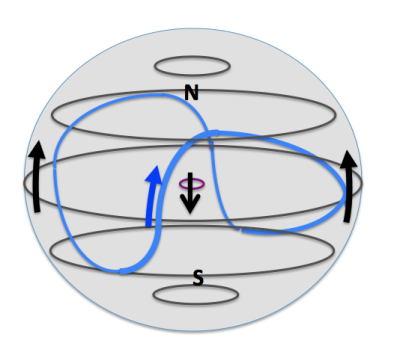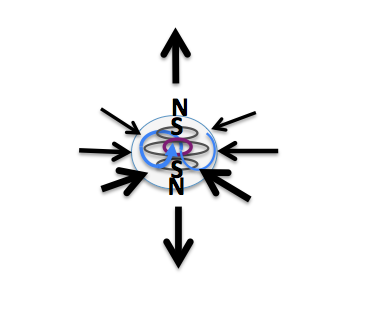Electrons and Positrons
Electrons
A new understanding of the nature of electrons is developed from the Subtle Atomics "wave-particle equivalence" principle. Electrons are recognised as wave structures much larger than the nucleus in contrast with traditional "point particle" electrons (Mills, 2016).
Based on "wave-particle equivalence" particle sizes are expected to be directly related to mass with more massive (higher energy) particles being smaller, and less massive (lower energy) particles being larger.
A linear "wave-particle equivalence" relationship would mean that electrons are around 1,840 times larger than nucleons, in accordance with the mass ratios of electrons to nucleons. The size of free, unbound electrons may be close to this size.
The observed size of atomic and molecular electron orbitals varies considerably, but is generally even larger than a inverse linear relationship might suggest. This increased size is expected to be due to due to electromagnetic interactions between electrons and nuclei.
The geometry of bonding electrons (i.e. elliptical rather than spherical) is another example of how electro-magnetic interactions can modify electron shape.

Copyright S. Brink.
Electron Extents for Atomic Hydrogen
Bohr Radius: 53,000fm
"Wave-particle equivalence" Radius:
1,600fm
The observed atomic electron extents are much larger than expected by "wave-particle equivalence".



Nucleus
Nucleus
Nucleus
Copyright S. Brink.
Copyright S. Brink.
Copyright S. Brink.
Electron Ground State, n=1
First Excited State, n=2
First De-excited State, n=1/2
One torsional rotation per rotation
Two torsional rotations per rotation
Half a torsional rotation per rotation
In the new model, electrons are defined as having circular orbits that rotate, forming spherical or elliptical structures.
The ground state electron (n=1) is modelled as having one oscillation per rotation.
Excited states, which are larger, are modelled as having more than one oscillation per rotation, for example:
- n=2 -> 2 wavelengths per rotation,
- n=3 -> 4 wavelengths per rotation,
- n=4 -> 8 wavelengths per rotation,... etc.
The model is also consistent with the potential existance of de-excited electrons with total energies less than ground state electrons. De-excited electrons are modelled as having a fractional number of oscillations per rotation,
- n=1/2 -> 1/2 a wavelength per rotation,
- n=1/3 -> 1/4 a wavelength per rotation,
- n=1/4 -> 1/8 a wavelength per rotation,... etc.

Nucleus----------->
Nucleus---------->
Copyright S. Brink.
Bonding Electron Pair with Double Poles
If Below Ground State Electrons are Possible, Why Don't Electrons Transition to these States Under "Normal Terrestrial Conditions?
Under terrestrial conditions (i.e. on earth) electrons are generally observed as ground state electrons, not as de-excited electons. Why is this? Reaction thermodynamics suggests that electrons should favour transiton to these lower energy states, if they do exist.
To understand why most electrons are at "ground state" requires a recognition of an interaction between background energy and mass. In the new model, particles, including electrons, can continually absorb background energy, transitioning to higher and higher quantised energy states. De-excited electrons (n<1) can transition to less de-excited states, then to ground state (n=1). Ground state electrons can transition to various excited states (n>1).
Ground state electrons are stable and de-excited electrons are also expected to be stable. Energy states above ground state are unstable, decaying by photon emission to a lower energy states.
Consequently the new model identifies that electrons naturally absorb background energy, transitioning to the highest stable energy state. Under terrestrial conditions, the highest stable energy state is ground state (n=1).

Copyright S. Brink.
Excited and De-excited Electron Properties
The Rydberg Equation describes transition energies between ground state electrons (n=1) and excited states (n=2,3,4,...). Mills (2016) proposes an extension of the Rydberg equation, describing de-excited states as fractional n values.
The Subtle Atomics electron model has similarities to that proposed by Mills, but differs as it identifies an exponential relationship (rather than a linear relationship) between the Rydberg "n" value and the number of oscillations per rotation. As electron size (radius) is proportional to the number of oscillations per rotation, the relationship between Rydberg "n" values and electron radius is also exponential.
The proposed relationship for determining the relative size of excited and de-excited states is:
Electron radius (n) = Ground state radius (n=1) x 2^(n-1)
where n = 1, 2, 3,... or 1/2, 1/3, 1/4,...
Have De-excited Electrons Been Observed?
Have De-excited Electrons Been Observed?
Experimental evidence of de-excited electron states was perhaps was first reported in 1991, (Bush et alia), following theoretical proposal by R. Mills in around 1986.
Classical theory presented by Mills provides new insights into modern physics, but has a number of significant limitations, particularly as it does not consider the potential for electro-magnetic interactions between electrons and the nucleus.
Positrons
The positron is an example of a particle with similar mass to an electron (~511KeV), but displaying "positive" rather than "negative" behaviour in response to an electric field.
The observed difference in "charge" behaviour is expected to be due to a different electromagnetic field configuration compared to the electron. For example the positron field may be more "toroidal compared to the electron field which is expected to be more spherical.
The existance of electrons rather than positrons under normal conditions is consistent with the electron magnetic field configuration being stable, whereas the positron field configuration is unstable.
The positron size has not been described (?), but it could perhaps be close to the size expected for a particle of this mass in accordance with "wave-particle equivalence", i.e. ~1,840x larger than nucleons?

Copyright S. Brink.
Positron - A 511KeV particle in a
toroidal orbit?